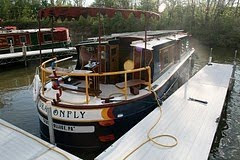The spiders on this boat are getting bolder every day. This means war!
Spiders are notoriously common on boats. There are so many tiny crevices where they can hole up by day. And there’s an endless supply of food, in the form of tiny flies. How do they get ON the boat? They may crawl aboard when you dock, using your mooring lines like gangplanks, but usually, they just parachute in, using tiny strands of silk like hot-air balloons.
 |
| Why there are so many spiders: There's lots of food, in the form of tiny flies. (Don't wear black while aboard or you'll get "fly dandruff") |
Each morning I diligently hunt down spiders with my whisk
broom. I destroy the webs, and I feed the webspinners to the fishes, completing
the Great Circle of Life. But
lately I’ve been wondering, when I send the big spiders overboard, am I just
opening up their environmental niches so NEW spiders can move into their
territories?
The Cap’n—who is probably tired of my sudden shrieks when
spiders appear in unexpected locations and my plaintive requests for his manly protection--went
to a marine supply store and bought me a large spray can gaily festooned with
nautical flags. The label reads:
“Captain Phab: Domestic Spider Control. Kills Spiders on Contact! (Read Label
Before Using.)”
On the back of the can, the fine print says that the
stuff is deadly to spiders--and also to humans, to little children, to domestic
animals, and especially to fish. (So . . . you
spray it on your boat, and then you never, ever wash your boat again?)
“Care should be taken to
avoid depositing the product onto surfaces or introducing the material into the
air,” the label says (emphasis added). Great. This is a
spray can. If I’m not supposed to introduce it into the air, how do I spray it? And if I can’t spray the stuff on surfaces, where do I spray it? Onto individual spiders? Have you seen how fast those suckers
move?
I went online, to a boater’s forum, to look for other
approaches to spider control.
Aside from the “Nuke ‘em with hazardous chemicals” approach, I noted these alternate spider control methods:
1) “One
medium-sized cat should do the job.”
2) “Teach your children to be entomologists
and they’ll collect the spiders for you. (First lesson, class: “How to identify the brown recluse and the
black widow.”)
3) “There’s an
electronic device that repels spiders.”
(Next post in the forum: “Yeah, our marina has one. It’s covered with spiderwebs.”
4) “Just
relax and enjoy the spiders. My
Harley Davidson has a couple of resident ‘extreme sport’ spiders who’ve been
riding with me all summer.” (Yeah, I'll show the spiders some extreme sports, all right.)
And
finally . . .
5) “I use a
digital approach to spider control. Take two digits, pinch the spider between
them, discard.”
Aha, so THAT’s how you use the can of spider spray! Apply five digits to can, suspend can over
spider, apply pressure. Repeat. The label says, "Kills spiders on contact."
Hey, Captain, can you come in here a second? There’s a seriously big spider over here . . .
Hey, Captain, can you come in here a second? There’s a seriously big spider over here . . .





I've been laughing about your spider posts. If you recall, at a young age I was your personal ninja spider control service.
ReplyDeleteI'm forever in your debt. Be proud of me, I've become much braver through necessity.
ReplyDelete